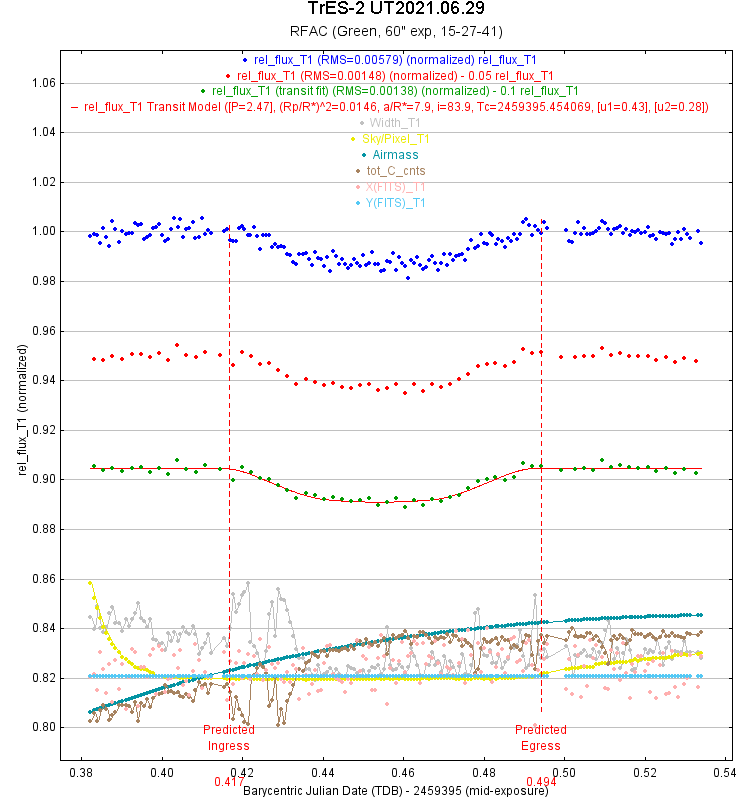Exoplanets
In 2018, Richard Tonello (head astronomer at GDC in Gingin, Australia) told me he wanted to record exoplanet transits; I thought 'this would be very difficult to achieve with our equipment' !!!
Early 2021 I found myself trying to image those transits and for my surprise it was something that could be achieved with amateur equipment. First attempts were analyses through Mathematica software with homemade algorithms, although results were pretty accurate, they're challenging to be interpreted by other people.
During my 2021 summer holidays in Lanzarote, Spain, I'd started the Exoplorer Course by Boyce Astro in order to learn more about exoplanets. Patrick Boyce put together a great beginners course and introduce me to AstroImageJ software which was developed by MIT-AAVSO guys for NASA missions.
That led my to attend the AAVSO Exoplanets course in November 2021. Dennis Conti (head of Exoplanet Section at AAVSO) was one of the key speaker and introduce us to the collaboration work that amateurs can do to help professionals on this field.
In March 2022 I found myself applying to become a member of TESS (Transiting Exoplanet Survey Satellite) Sub-Group 1 (SG1). After the mandatory examination, I'd being accepted as part of the team. I feel so privileged to be part of the 26 AAVSO's fellows inside the ~300 SG1 members :)
The aim of this group is to produce and analyse ground based images of TESS Objects of Interest in order to confirm or rule out the presence of exoplanets.
I'm very grateful of having this opportunity to directly collaborate with the professional and do real science :) !!!
Early 2021 I found myself trying to image those transits and for my surprise it was something that could be achieved with amateur equipment. First attempts were analyses through Mathematica software with homemade algorithms, although results were pretty accurate, they're challenging to be interpreted by other people.
During my 2021 summer holidays in Lanzarote, Spain, I'd started the Exoplorer Course by Boyce Astro in order to learn more about exoplanets. Patrick Boyce put together a great beginners course and introduce me to AstroImageJ software which was developed by MIT-AAVSO guys for NASA missions.
That led my to attend the AAVSO Exoplanets course in November 2021. Dennis Conti (head of Exoplanet Section at AAVSO) was one of the key speaker and introduce us to the collaboration work that amateurs can do to help professionals on this field.
In March 2022 I found myself applying to become a member of TESS (Transiting Exoplanet Survey Satellite) Sub-Group 1 (SG1). After the mandatory examination, I'd being accepted as part of the team. I feel so privileged to be part of the 26 AAVSO's fellows inside the ~300 SG1 members :)
The aim of this group is to produce and analyse ground based images of TESS Objects of Interest in order to confirm or rule out the presence of exoplanets.
I'm very grateful of having this opportunity to directly collaborate with the professional and do real science :) !!!
CLICK ON AN IMAGE TO
VIEW IT AT FULL RESOLUTION
|
HAT-P36b
Date: 2022.01.17 Images: 262 x 60" Lum Star coordinates: 12h33m04s; +44d54m55s Star magnitude: 12.14 Star radius: 1.10 Solar radius Planet radius: 1.277 Jupiter radius Transit period: 1.33 days Transit duration: 2:14 hours Transit depth: 15.9 ppt (parts per thousand= a drop of the star magnitude of ~1.59%) Telescope: Meade LX850 12" Camera: QHY268 |




